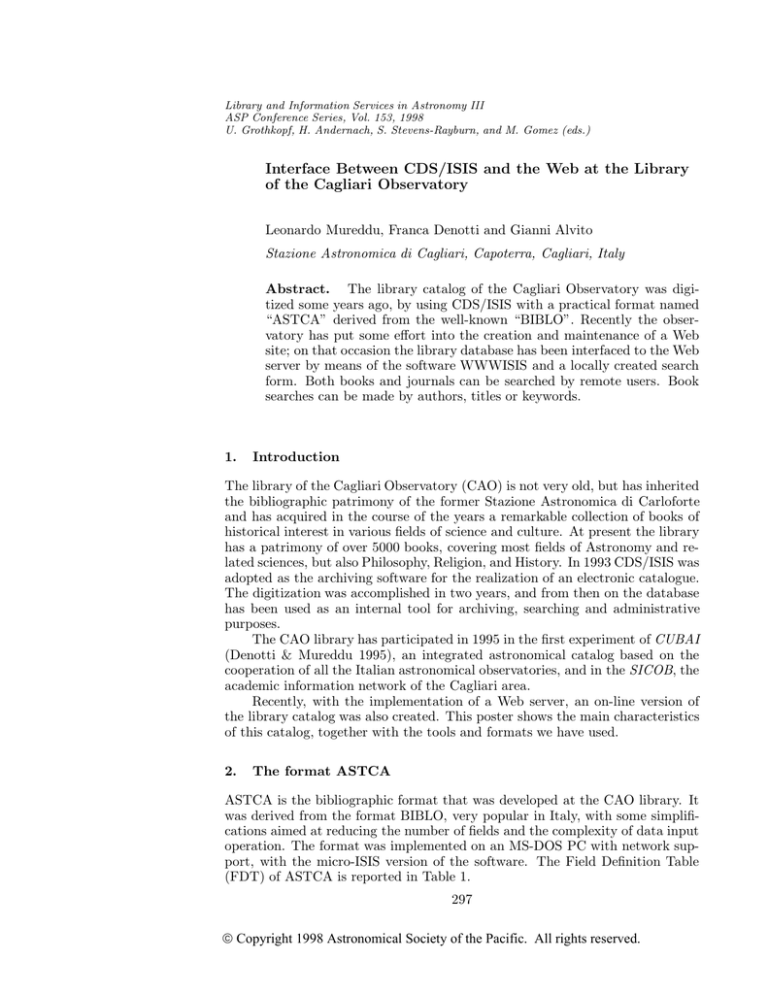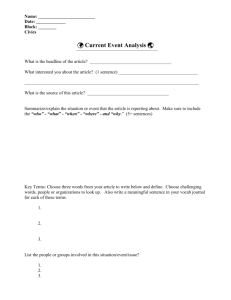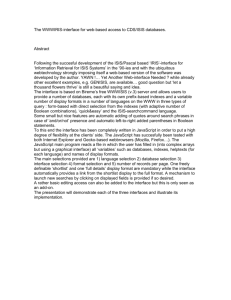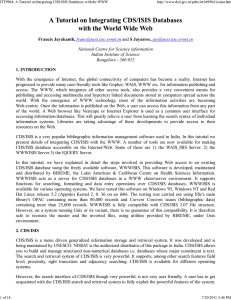
Library and Information Services in Astronomy III
ASP Conference Series, Vol. 153, 1998
U. Grothkopf, H. Andernach, S. Stevens-Rayburn, and M. Gomez (eds.)
Interface Between CDS/ISIS and the Web at the Library
of the Cagliari Observatory
Leonardo Mureddu, Franca Denotti and Gianni Alvito
Stazione Astronomica di Cagliari, Capoterra, Cagliari, Italy
Abstract. The library catalog of the Cagliari Observatory was digitized some years ago, by using CDS/ISIS with a practical format named
“ASTCA” derived from the well-known “BIBLO”. Recently the observatory has put some effort into the creation and maintenance of a Web
site; on that occasion the library database has been interfaced to the Web
server by means of the software WWWISIS and a locally created search
form. Both books and journals can be searched by remote users. Book
searches can be made by authors, titles or keywords.
1.
Introduction
The library of the Cagliari Observatory (CAO) is not very old, but has inherited
the bibliographic patrimony of the former Stazione Astronomica di Carloforte
and has acquired in the course of the years a remarkable collection of books of
historical interest in various fields of science and culture. At present the library
has a patrimony of over 5000 books, covering most fields of Astronomy and related sciences, but also Philosophy, Religion, and History. In 1993 CDS/ISIS was
adopted as the archiving software for the realization of an electronic catalogue.
The digitization was accomplished in two years, and from then on the database
has been used as an internal tool for archiving, searching and administrative
purposes.
The CAO library has participated in 1995 in the first experiment of CUBAI
(Denotti & Mureddu 1995), an integrated astronomical catalog based on the
cooperation of all the Italian astronomical observatories, and in the SICOB, the
academic information network of the Cagliari area.
Recently, with the implementation of a Web server, an on-line version of
the library catalog was also created. This poster shows the main characteristics
of this catalog, together with the tools and formats we have used.
2.
The format ASTCA
ASTCA is the bibliographic format that was developed at the CAO library. It
was derived from the format BIBLO, very popular in Italy, with some simplifications aimed at reducing the number of fields and the complexity of data input
operation. The format was implemented on an MS-DOS PC with network support, with the micro-ISIS version of the software. The Field Definition Table
(FDT) of ASTCA is reported in Table 1.
297
Copyright 1998 Astronomical Society of the Pacific. All rights reserved.
298
L. Mureddu, F. Denotti and G. Alvito
Tag
01
02
03
04
05
06
07
10
12
13
18
41
42
51
52
61
62
63
71
72
73
74
87
88
89
91
92
94
Field name
Title/responsible entity
Edition
Typology
Imprint
Description
Collection
Condition
Notes
Language
Country
ISBN/ISSN
Personal author
Corporate author
Add. pers. authors
Add. corp. authors
Subjects (keywords)
CDD
Abstract
Location
Date of cataloging
Operator
Inventory number
Loan permitted
State of loan
On loan to
Acquisition
Price or value
Check
Table 1.
3.
Rep
R
R
R
R
R
R
R
R
R
R
R
R
R
R
R
Type
X
X
A
X
X
X
X
X
A
X
X
X
X
X
X
X
X
X
X
N
A
X
A
A
X
A
X
A
Length
800
100
2
240
240
240
100
400
3
12
100
240
240
240
240
400
15
480
50
6
2
30
1
1
200
2
100
2
Subfields
tscdra
er
lndsta
ea
tprav
bs
cnq
1qa2b
cnq
1qa2b
st
si
dn
cfs
Field Definition Table of ASTCA
Interface between ISIS and the Web: client-server applications
Since the first diffusion of the World Wide Web many efforts have been devoted
to the creation of interfaces to be used with the existing library databases, in
particular those based upon CDS/ISIS.
Two approaches have been exploited:
• Export of the database, i.e. translation of the data from the ISIS format
to another (plain text, ISO 2709, and so on) in order to make the material
searchable by means of other tools.
• Creation of an ISIS-interface to search the Master File in the same format
as created and updated by the librarian.
Both methods have been widely used in the last years. For instance, the
first realization of the CUBAI project (Ferrucci & Balestra 1994) for an integrated astronomical catalog in Italy was based on the WAIS search engine on
an export of the databases to text files. A second approach was the realization
of a WAIS-ISIS interface to search the database itself. It is obvious that this
Interface Between CDS/ISIS and the Web
Figure 1.
299
Scheme of the interface.
second approach is preferable because it offers the real-time searchability of the
catalog.
The solution to be adopted strongly depends on the hardware platform
where the CDS/ISIS software is installed. The library catalog at CAO is based
on a PC running CDS/ISIS under WIN-95. The WWW server is run on a second
computer (http://www.ca.astro.it), which acts as main gateway for all incoming
requests as well as outgoing data. The scheme of the interface is given in Fig. 1.
The software we adopted is WWWISIS, developed and distributed in Brazil
by the BIREME organization. It is designed to act as a server for ISIS databases
in a WWW client-server environment, with a CGI interface developed in Perl
language. Figures 2 and 3 show the homepage and the search form for the
book catalog. A useful feature of the search interface is the possibility to pick a
keyword from a pop-up list in the form.
References
Denotti, F. & Mureddu, L. 1995, 1st CUBAI Workshop: Rome 1995
Ferrucci, M.& Balestra A. 1994, WWWorkshop: Padova 1994
300
L. Mureddu, F. Denotti and G. Alvito
Figure 2.
Homepage of Cagliari Observatory
Figure 3.
The search module






